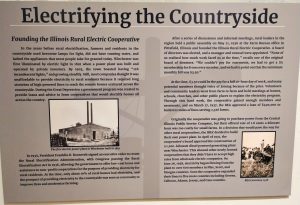Text:
Electrifying the Countryside
Founding the Illinois Rural Electric Cooperative
In the years before rural electrification, farmers and residents in the countryside used kerosene lamps for light, did not have running water, and lacked the appliances that most people take for granted today. Winchester was first illuminated by electric light in 1891 when a power plant was built and operated by private investors. By 1903, the town boasted having “126 incandescent lights,” and growing steadily. Still, most companies thought it was unaffordable to provide electricity to rural residents because it required long stretches of high powered lines to reach the remote homes scattered across the countryside. During the Great Depression a government program was created to provide loans and advice to form cooperatives that would electrify homes all across the country.
In 1935, President Franklin D. Roosevelt signed an executive order to create the Rural Electrification Administration, with Congress passing the Rural Electrification Act in 1936, allowing the government to offer low-cost loans and assistance to non-profit cooperatives for the purpose of providing electricity for rural residents. At the time, only about 10% of rural homes had electricity, and the prospect of providing electricity to the countryside was seen as a necessity to improve lives and modernize farming.
After a series of discussions and informal meetings, rural leaders in the region held a public assembly on May 21, 1936 at the Farm Bureau office in Pittsfield, Illinois and founded the Illinois Rural Electric Cooperative. A board of directors was elected, and a manager and counsel were appointed. “None of us realized how much work faced us at the time,” recalls one of the original board of directors. “We couldn’t pay for easements, we had to get a $5 membership fee from every member, and we had to point out that the minimum monthly bill was $3.50.”
At the time, $3.50 could be the pay for a full 10-hour day of work, and many potential members thought twice of joining because of the price. Volunteers and community leaders went from farm to farm and held meetings at homes, schools, churches, and other public places to explain the electricity program. Through this hard work, the cooperative gained enough members and easements, and on March 17, 1937, the REA approved a loan of $490,000 to build 622 miles of lines serving 2,326 farms.
Originally the cooperative was going to purchase power from the Central Illinois Public Service Company, but their offered rate of 1.8 cents a kilowatt hour was too costly for small farms. In a decision that would pave the way for other rural cooperatives, the IREC decided to build their own power plant. In April of 1937, the cooperative’s board approved the construction of a 1,200-kilowatt diesel powered generating plant near Winchester. This showed other newly formed cooperatives that they didn’t have to accept high rates from wholesale electric companies. On June 28, 1938, electricity began flowing from the plant to over 600 members in Pike, Scott, and Morgan counties. Soon the cooperative expanded their lines to five more counties including Greene, Calhoun, Adams, Jersey, and Cass counties.




